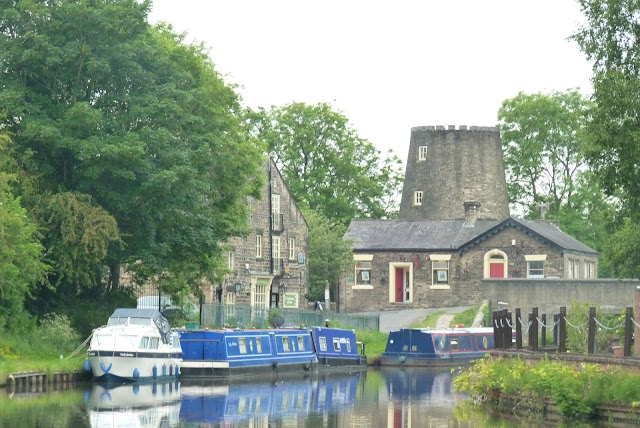Just as we were preparing to let go I heard the lock working astern of us. It was a GRP cruiser going our way. As they passed I asked if they would mind sharing the lock with us. They were a little reluctant, understandably as they would be a little faster than us and plastic and steel don't really mix in a lock! However it did make it much easier for both of us.
Terminal Warehouse with the two arches for boats to dealt with undercover. Built in 1777 and rebuilt in 1984.
The Orwell Pub on the left is the converted Gibson's Warehouse built 1777 and rebuilt 1984. The tower on the right is the Trencherfield Mill. It was built in 1907 and was a cotton mill. It was powered by a 2500HP triple expansion steam engine built by J&E Wood of Bolton. It drove a 26' wheel at 68 rpm and had 56 ropes on it to drive the machinery. The mill closed in 1968. The steam engine was saved and is run every Sunday. The mill was converted into apartments in 1990's.
We did two locks with the cruiser and then they stopped for a cup of tea. We pottered on to Dean Lock and found a boat taking water at the foot of the lock. They very kindly helped Helen with the gate. The lock is very close to the M6. Two locks have been replaced by a single lock. The elevated M6 seemed to set off the locks and lock keepers house.
Dean Lock with the M6 in the background. To the left are the old pair of locks and to the right the clock in use today with the Keepers cottage.
We had one more lock to do at Appley but once again Helen had help as there was a community broad beam vessel coming up in the lock. It was the Rose of Parbold with 12 passengers aboard. They were very friendly and even when they had left there was another boat waiting to come up who also gave a had. They had often been to Kilnsea so new out boat name and port of registry.
Parbold Village with old mill.
After Parbold we passed a sewage farm. On the canal before and after were pill boxes from WWII. In the canal guide it said that they were positioned to protect a top secret base that was the sewage farm! It was the scene of experiments to convert sewage into rocket fuel! A quick look in Google didn't show anything up.
WWII pill box 'protecting' the sewage farm.
We had heard that there was a Heritage Weekend at Burscough where we had thought to moor so instead of risking there being no room we stopped earlier out in the country. Once moored we had lunch and then decided to walk the couple of miles into Burscough to by some stuff and have a look about. We passed the junction where the branch to Rufford leaves. This is the way to the Ribble Link where you can get on to the Lancaster Canal. You have to book well in advance so we will have to try again next year.
Rufford Junction with three locks close by and canal workers cottages taken from the bridge. There is also a dry dock here that is covered but doesn't look as though it has been used for a long time.
As we walked down the tow path we came across Aiscough Mill. It was a flour mill that was built in 1855. It finished work in the 1980's and has been lucky not to have been knocked down. It is currently being converted into 56 apartments and 66 houses on the land.
Aiscough Mill with the covered unloading wharf where wheat from Liverpool was discharged. The railway was used also. The bridge was built in 1848 Joseph Butler Ltd of Stanningley near Leeds.
There was a narrow boat at Burscough for the festival that sold wool. Helen bought a couple of hanks of wool for her crocheting. On the way back we collected heads of elder flower as we are going to make elder flower cordial. I hope it works and tastes okay.







No comments:
Post a Comment